child lock CHEVROLET BLAZER 1993 Owners Manual
[x] Cancel search | Manufacturer: CHEVROLET, Model Year: 1993, Model line: BLAZER, Model: CHEVROLET BLAZER 1993Pages: 386, PDF Size: 20.7 MB
Page 28 of 386
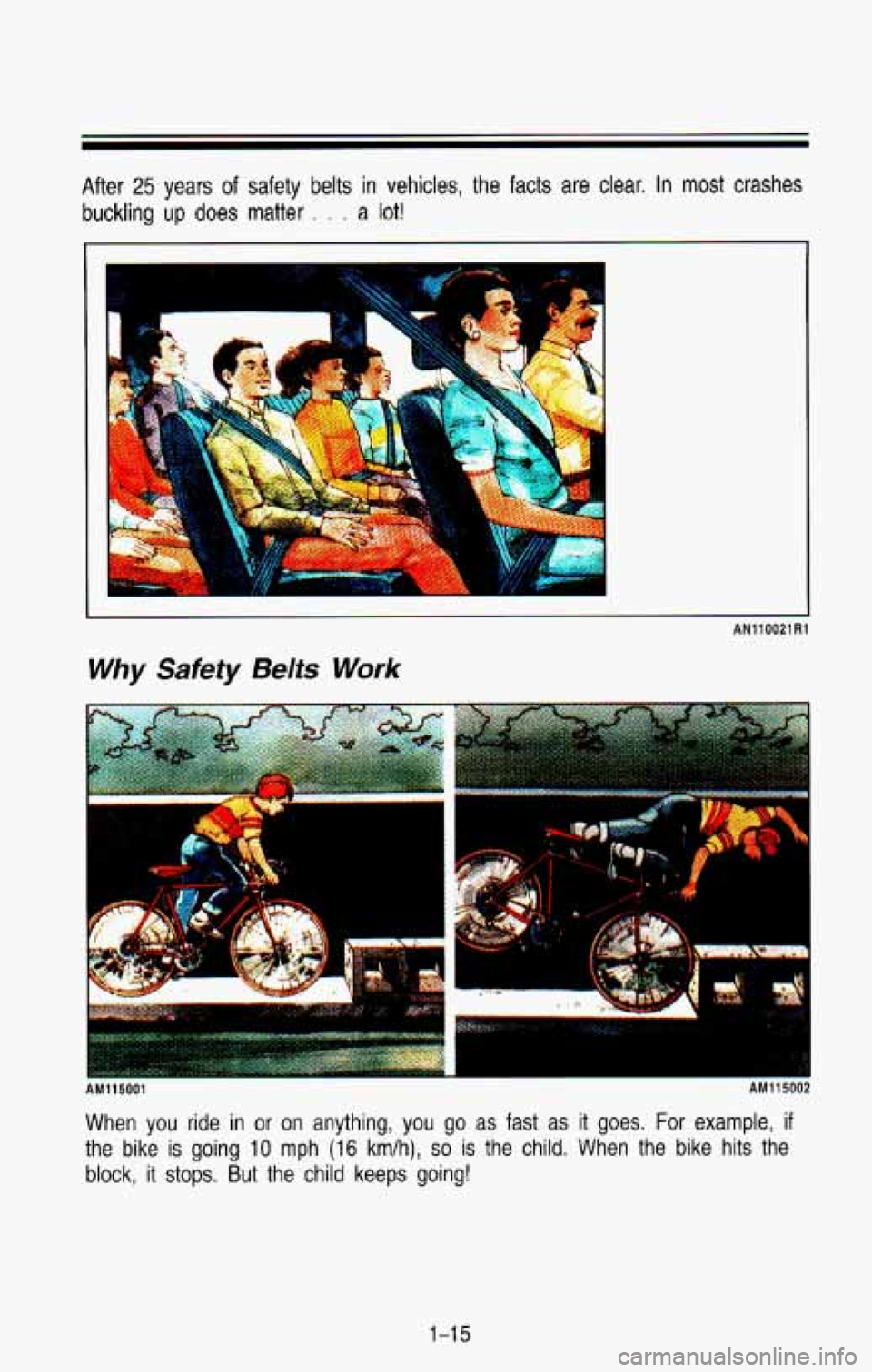
After 25 years of safety belts in vehicles, the facts are clear. In most crashes
buckling up does matter . . . a lot!
I
I AN110021R1
Why Safety Belts Work
AM115001 AMllbUd2
When you ride in or on anything, you go as fast as it goes. For example, if
the bike is going 10 mph (16 km/h), so is the child. When the bike hits the
block, it stops.
But the child keeps going!
1-15
Page 55 of 386
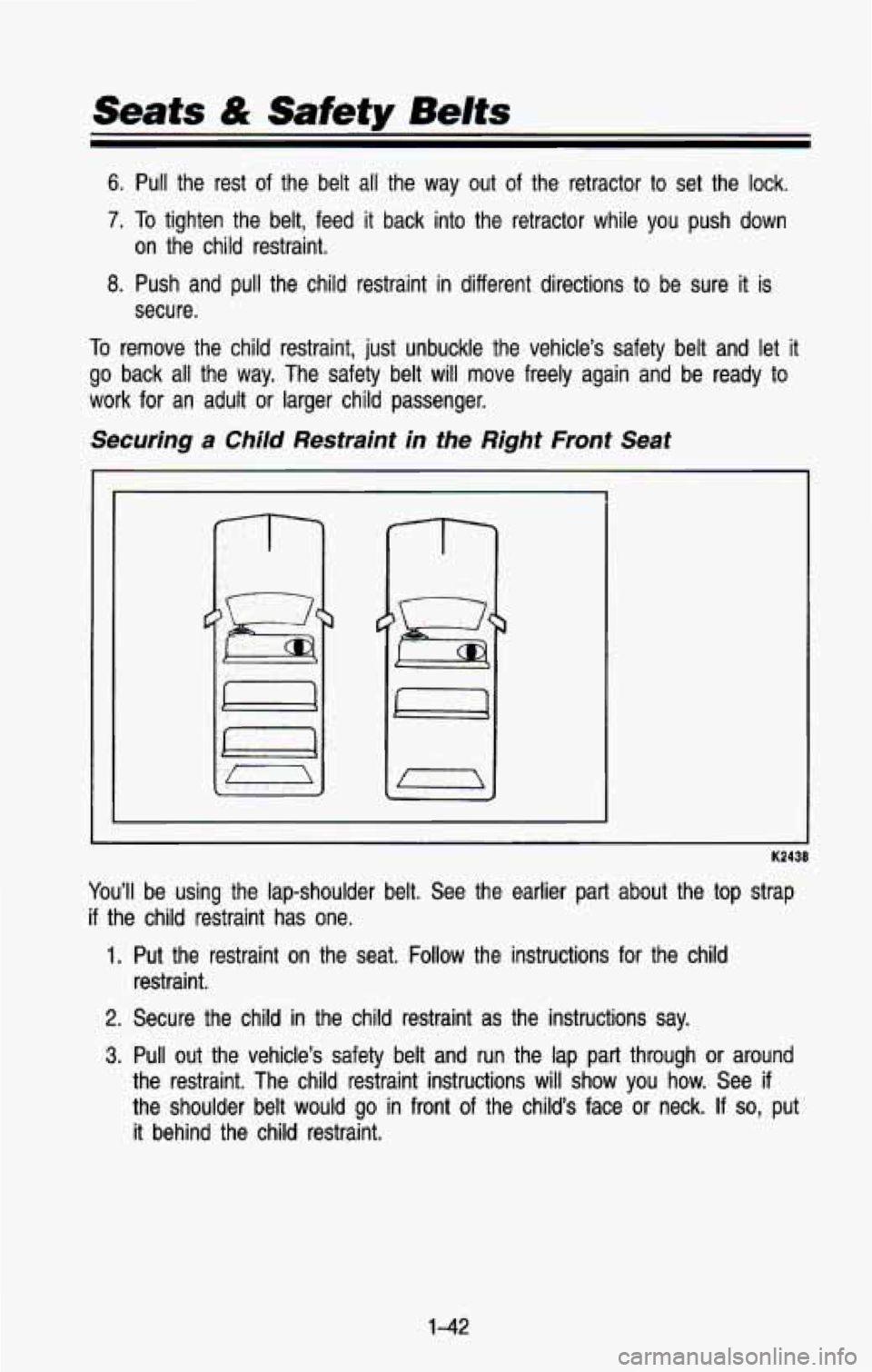
Seats & Safety Belts
6. Pull the rest of the belt all the way out of the retractor to set the lock.
7. To tighten the belt, feed it back into the retractor while you p\
ush down
8. Push and pull the child restraint in different directions to be sure
it is
To remove the child restraint, just unbuckle the vehicle’s safet\
y belt and let it
go back all the way. The safety belt will move freely again and be ready to
work for an adult or larger child passenger.
Securing a Child Restraint in the Right Front Seat
on the child restraint.
secure.
You’ll be using the lap-shoulder belt. See the earlier part about the\
top strap
if the child restraint has one.
1. Put the restraint on the seat. Follow the instructions for the child
restraint.
2. Secure the child in the child restraint as the instructions say.
3. Pull out the vehicle’s safety belt and run the lap part th\
rough or around
the restraint. The child restraint instructions will
show you how. See if
the shoulder belt would go in front of the child’s face or neck. If so, put
it behind the child restraint.
1-42
Page 56 of 386
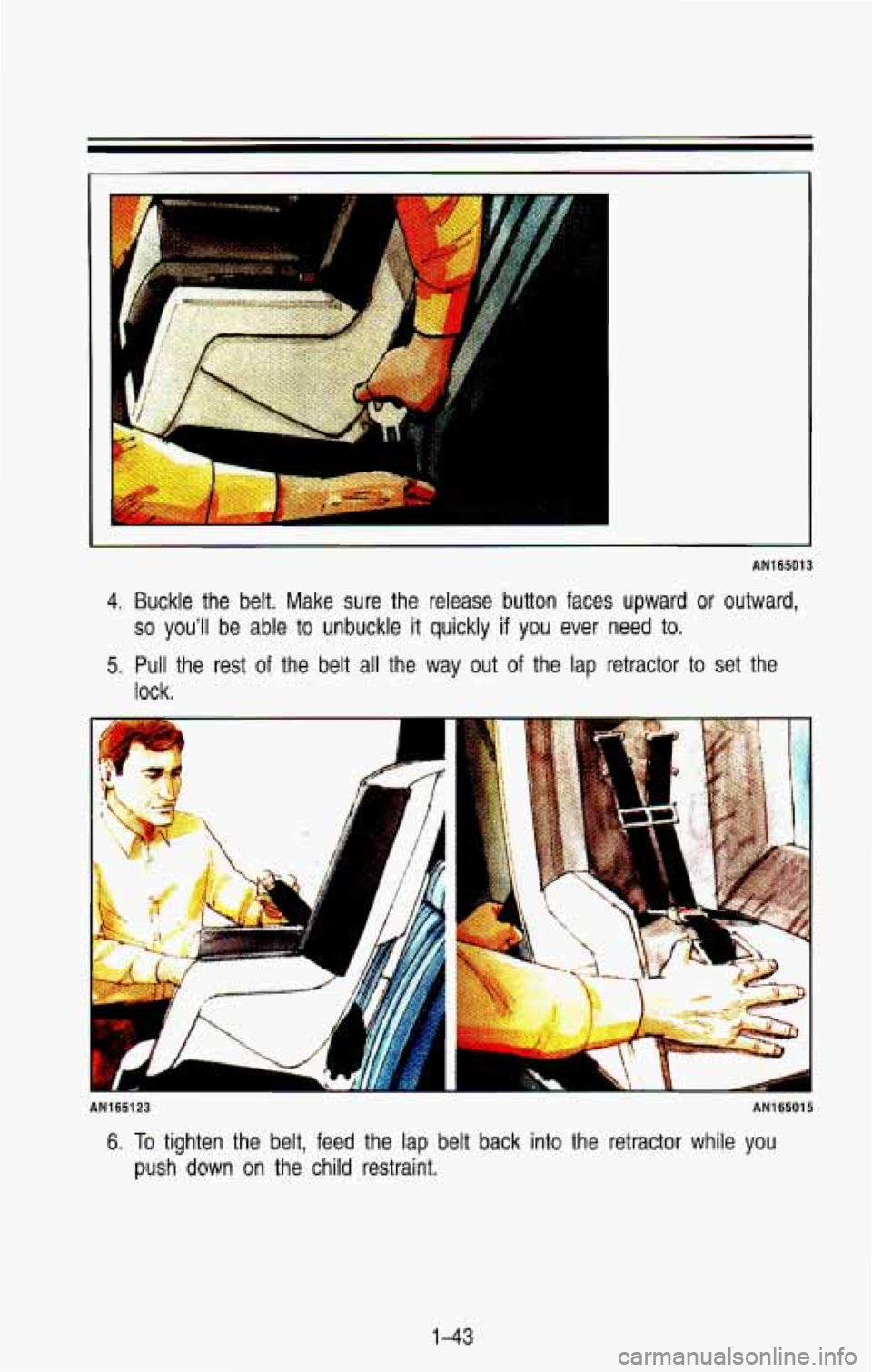
AN165013
4. Buckle the belt. Make sure the release button faces upward or outward,
so you'll be able to unbuckle it quickly if you ever need to.
5. Pull the rest of the belt all the way out of the lap retractor to set the
lock.
AN1 651 23 AN165015
6. To tighten the belt, feed the lap belt back into the retractor while you
push down on the child restraint.
1-43
Page 69 of 386
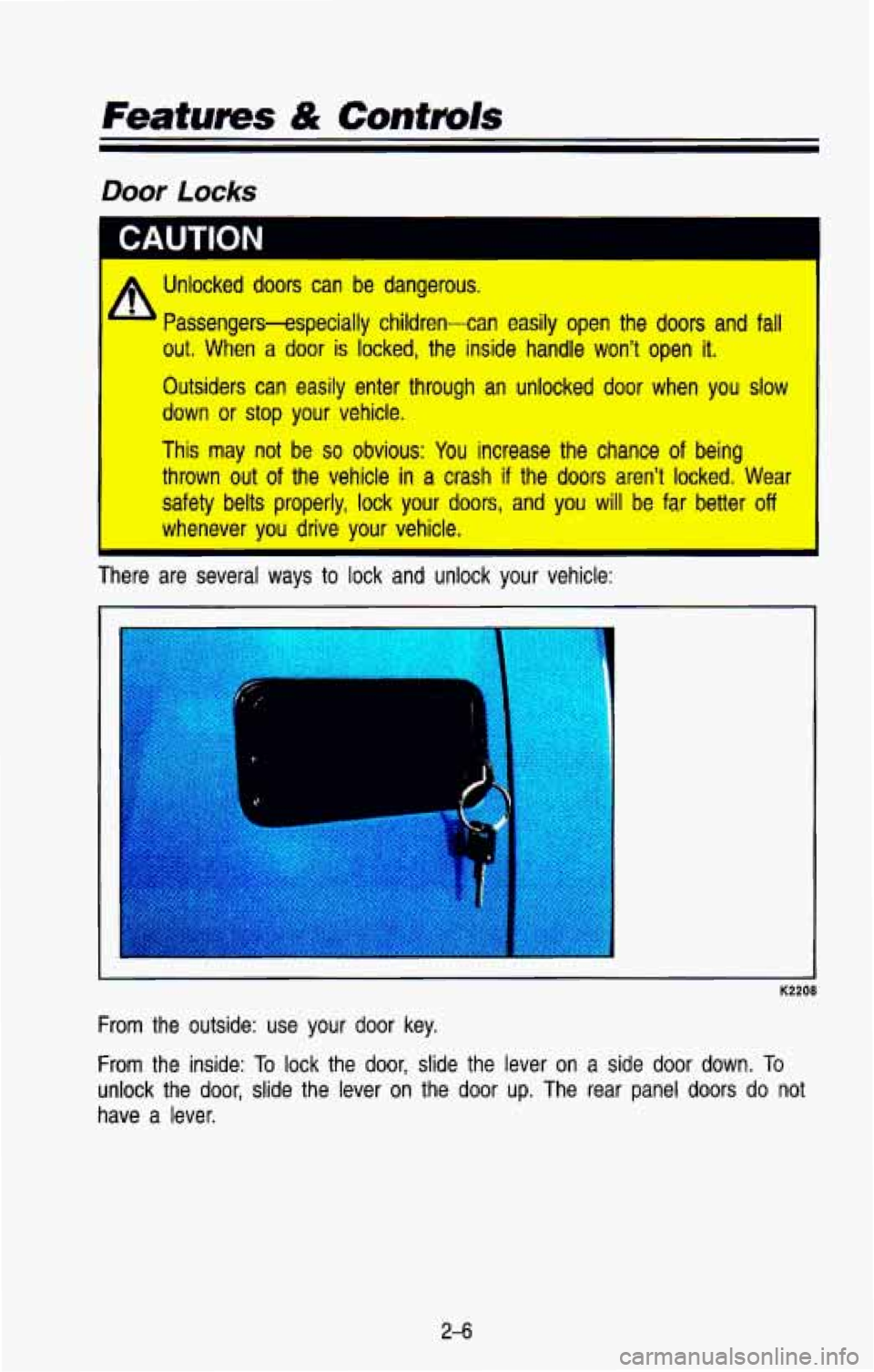
Featurns & Controls
A Unlocked doors can be dangerous. I
Passengers-especially children-can easily open the doors and fall
out. When a door is locked, the inside handle won’t open it.
Outsiders can easily enter through an unlocked door when you slow
This may not be so obvious: You increase the chance of being
thrown out
of the vehicle in a crash if the doors aren’t locked. Wear
safety belts properly, lock your doors, and you will be far better off
whenever you drive your vehicle. I
I down or stop your vehicle.
There are several ways to lock and unlock your vehicle:
From the outside: use your door key.
From the inside: To lock the door, slide the lever on a side door down. To
unlock the door, slide the lever on the door up. The rear pa\
nel doors do not
have a lever.
2-6
Page 186 of 386
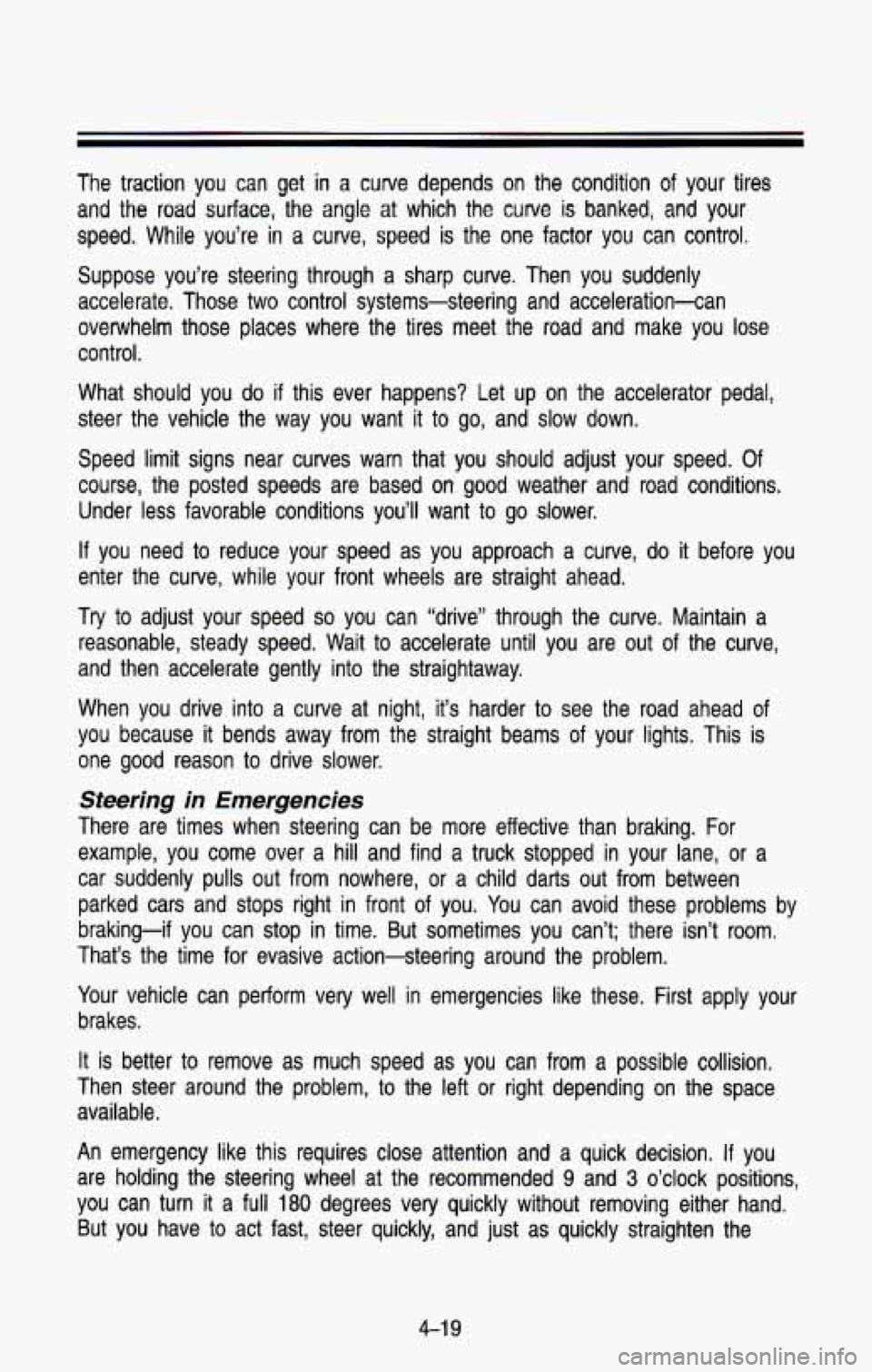
The traction you can get in a curve depends on the condition of your tires
and the
road surface, the angle at which the curve is banked, and your
speed. While you’re in
a curve, speed is the one factor you can control.
Suppose you’re steering through a sharp curve. Then you suddenly
accelerate. Those two control systems-steering and acceleration-ca\
n
overwhelm those places where the tires meet the road and make \
you lose
control.
What should you do if this ever happens? Let up on the accel\
erator peaal,
steer the vehicle the way you want it
to go, and slow down.
Speed limit signs near curves warn that you should adjust your\
speed. Of
course, the posted speeds are based
on good weather and road conditions.
Under less favorable conditions you’ll want
to go slower.
If you need to reduce your speed as you approach a curve, do it before you
enter the curve, while your front wheels are straight ahead.
Try to adjust your speed so you can “drive” through the curve. Maintain a
reasonable, steady speed. Wait to accelerate until
you are out of the curve,
and then accelerate gently into the straightaway.
When you drive into
a curve at night, it’s harder to see the road ahead of
you because it bends away from the straight beams
of your lights. This is
one
good reason to drive slower.
Steering in Emergencies
There are times when steering can be more effective than braki\
ng. For
example, you come over a hill and find a truck stopped in your lane, or a
car suddenly pulls out from nowhere,
or a child darts out from between
parked cars and stops right in front of you. You can avoid these problems by
braking-if you can stop in time. But sometimes you can’t; there isn’t room.
That’s the time for evasive action-steering around the proble\
m.
Your vehicle can perform very well in emergencies like these. First \
apply your
brakes.
It is better
to remove as much speed as you can from a possible collision.
Then steer around the problem, to the left or right depending \
on the space
available.
An emergency like this requires close attention and a quick decision.
If you
are holding the steering wheel at the recommended
9 and 3 o’clock positions,
you can turn it a full
180 degrees very quickly without removing either hand.
But you have
to act fast, steer quickly, and just as quickly straighten the
4-1 9
Page 377 of 386
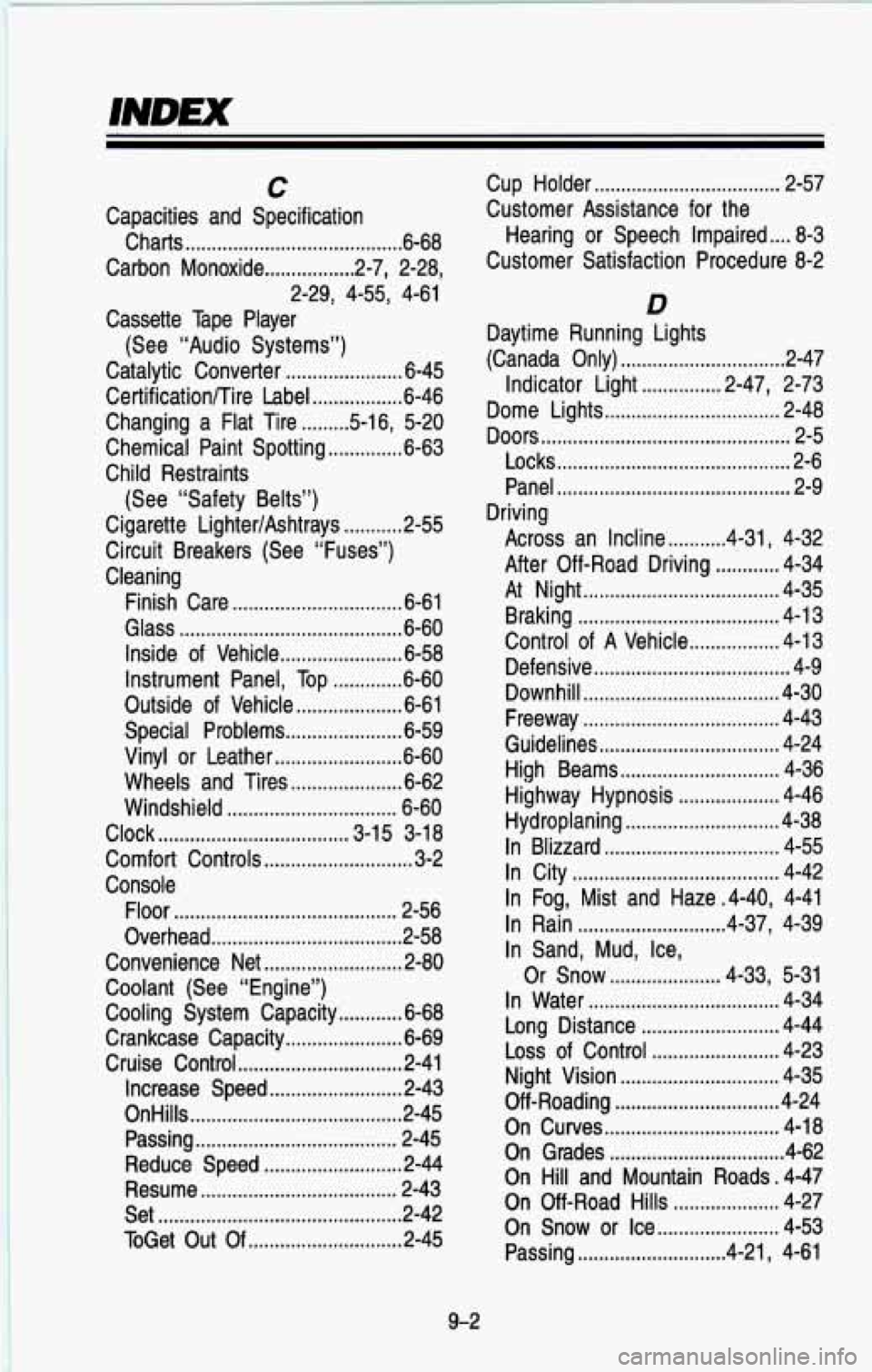
INDEX
C
Capacities and Specification Charts
......................................... 6-68
Carbon Monoxide
................. 2.7. 2.28.
Cassette Tape Player
Catalytic Converter
...................... 6-45
Certificationnire Label
................. 6-46
Changing a Flat Tire
......... 5.16. 5-20
Chemical Paint Spotting
.............. 6-63
Child Restraints 2.29. 4.55.
4-61
(See “Audio Systems”)
(See “Safety Belts”)
Cigarette LightedAshtrays
........... 2-55
Circuit Breakers (See “Fuses”)
Cleaning Finish Care
................................ 6-61
Glass
.......................................... 6.60
Inside of Vehicle
....................... 6-58
Instrument Panel. Top
............. 6-60
Outside of Vehicle
.................... 6-61
Special Problems
...................... 6-59
Vinyl
or Leather ........................ 6-60
Wheels and Tires
..................... 6-62
Windshield
................................ 6-60
Comfort Controls
............................ 3-2
Console
Floor
.......................................... 2-56
Overhead
.................................... 2.58
Convenience Net
.......................... 2-80
Coolant (See “Engine”)
Cooling System Capacity
............ 6-68
Crankcase Capacity
...................... 6-69
Cruise Control
............................... 2-41
Increase Speed
......................... 2-43
OnHills
........................................ 2-45
Clock
.................................... 3-15
3-18
Passing
...................................... 2-45
Reduce Speed
.......................... 2-44
Resume
..................................... 2-43
Set
.............................................. 2-42
ToGet Out Of
............................. 2-45 Cup Holder
................................... 2-57
Customer Assistance for the
Hearing
or Speech Impaired .... 8-3
Customer Satisfaction Procedure 8-2
D
(Canada Only) ............................... 2-47
Daytime Running Lights
Indicator Light
............... 2.47. 2-73
Dome Lights
................................. 2-48
Doors
............................................... 2-5
Panel
............................................ 2-9
Across an Incline
........... 4-31 . 4-32
After Off-Road Driving
............ 4-34
At Night ..................................... 4-35
Braking
...................................... 4-13
Control
of A Vehicle ................. 4-13
Defensive
..................................... 4-9
Downhill
..................................... 4-30
Freeway
..................................... 4-43
Guidelines
.................................. 4-24
High Beams
.............................. 4-36
Highway Hypnosis
................... 4-46
Hydroplaning
............................. 4-38
In Blizzard
................................. 4-55
In City
....................................... 4-42
In Fog. Mist and Haze .4.40. 4-41
In Rain
............................ 4.37. 4-39
In Sand. Mud. Ice.
Or Snow ..................... 4.33. 5-31
In Water
.................................... 4-34
Long Distance
.......................... 4-44
Loss of Control
........................ 4-23
Night Vision
.............................. 4-35
Off -Roading ............................... 4-24
On Curves
................................. 4-18
On Grades
................................. 4.62
On Hill and Mountain Roads
. 4-47
On Off-Road Hills
.................... 4-27
On Snow
or Ice ....................... 4-53
Passing
............................ 4-21 . 4-61
Locks
............................................ 2-6
Driving
9-2
Page 380 of 386
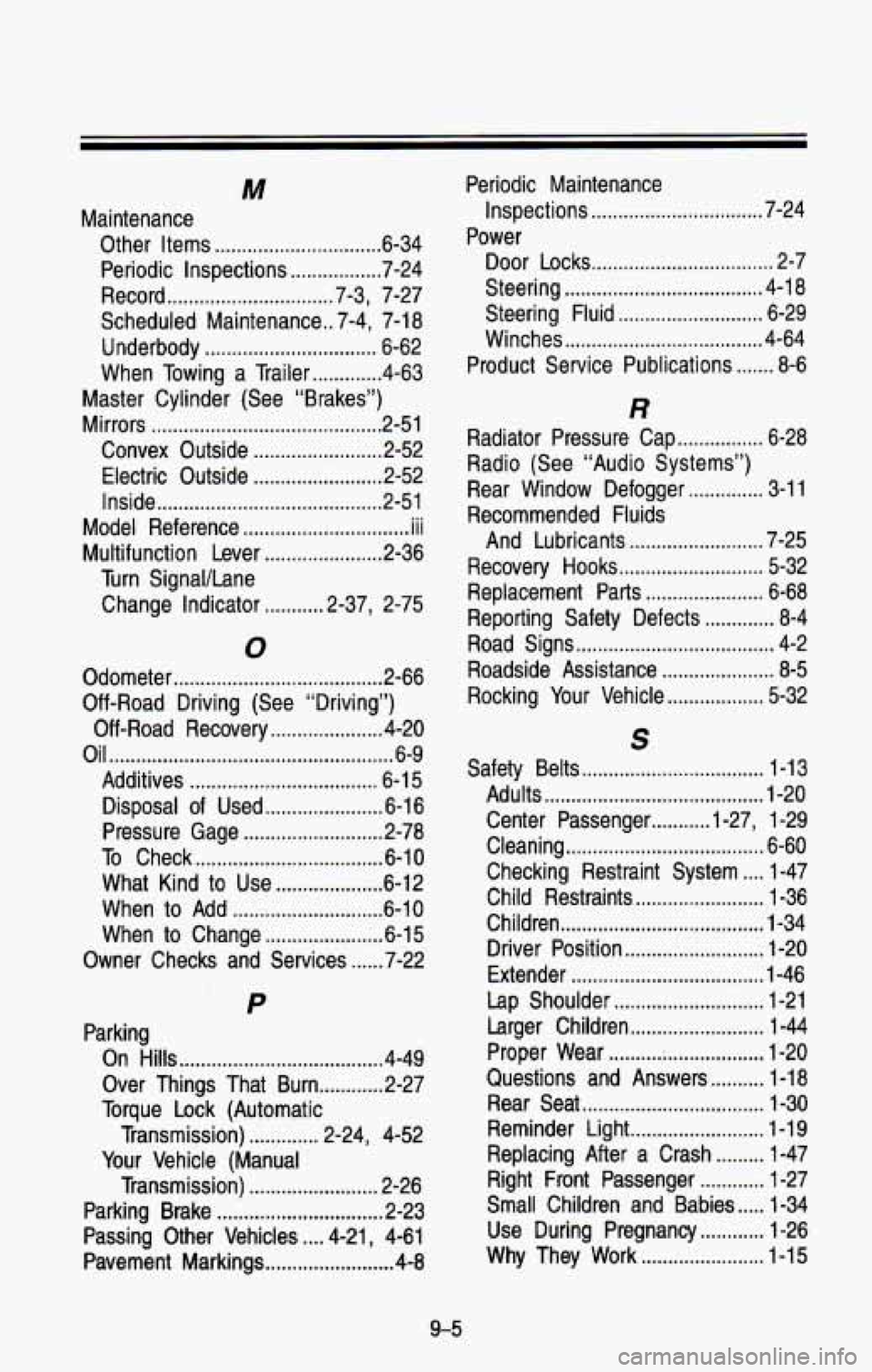
M
Maintenance Other Items
............................... 6-34
Periodic Inspections
................. 7-24
Record
............................... 7.3. 7-27
Scheduled Maintenance
.. 7.4. 7-1 8
Underbody
................................ 6-62
When Towing a Trailer
............. 4-63
Master Cylinder (See “Brakes”)
Mirrors
........................................... 2-51
Convex Outside
........................ 2-52
Electric Outside
........................ 2-52
Inside
.......................................... 2-51
Model Reference
............................... III
Multifunction Lever ...................... 2-36
...
Turn SignalLane
Change Indicator
........... 2-37, 2-75
0
Odometer ....................................... 2-66
Off-Road Driving (See “Driving”)
Off-Road Recovery
..................... 4-20
Oil ..................................................... 6-9
Additives
................................... 6-1 5
Disposal of Used ...................... 6-1 6
Pressure Gage
.......................... 2-78
To Check
................................... 6-1 0
What Kind to Use .................... 6-12
When
to Add ............................ 6-10
When
to Change ...................... 6-1 5
Owner Checks and Services ...... 7-22
Parking On Hills
...................................... 4.49
Over Things That Burn
............ 2-27
Torque Lock (Automatic
Transmission)
............. 2.24. 4-52
Your Vehicle (Manual Transmission)
........................ 2-26
Parking Brake
............................... 2-23
Passing
Other Vehicles .... 4.21. 4-61
Pavement Markings
........................ 4-8
Periodic Maintenance
Power Inspections
................................ 7-24
Door Locks
.................................. 2-7
Steering
..................................... 4-18
Steering Fluid
........................... 6-29
Winches
..................................... 4-64
Product Service Publications
....... 8-6
R
Radiator Pressure Cap ................ 6-28
Radio (See “Audio Systems”)
Rear Window Defogger
.............. 3-11
Recommended Fluids And Lubricants
......................... 7-25
Recovery Hooks
........................... 5-32
Replacement Parts
...................... 6-68
Reporting Safety Defects
............. 8-4
Road Signs
..................................... 4-2
Roadside Assistance
..................... 8-5
Rocking Your Vehicle
.................. 5-32
S
Safety Belts .................................. 1-13
Center Passenger
........... 1-27, 1-29
Cleaning
..................................... 6-60
Checking Restraint System
.... 1-47
Child Restraints
........................ 1-36
Children
...................................... 1-34
Driver Position
.......................... 1-20
Extender
.................................... 1-46
Lap Shoulder
............................ 1-21
Larger Children
......................... 1-44
Proper Wear
............................. 1-20
Questions and Answers
.......... 1-18
Rear Seat
.................................. 1-30
Replacing After a Crash
......... 1-47
Right Front Passenger
............ 1-27
Small Children and Babies
..... 1-34
Use During Pregnancy
............ 1-26
Why They Work ....................... 1-15
Adults
......................................... 1-20
Reminder Light
......................... 1-19
9-5